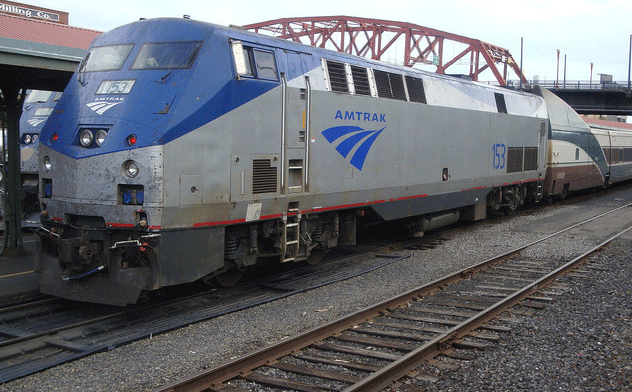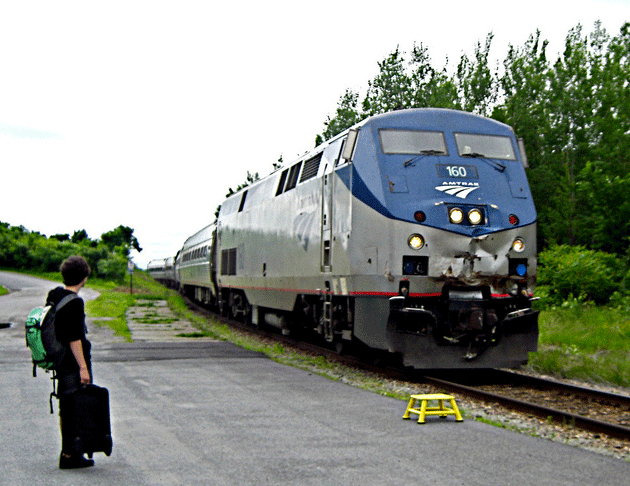Full Steam Ahead for Amtrak
Air Date: Week of September 14, 2012

(Environmental Blog Flickr Creative Commons)
Amtrak's ridership is up and subsidies from the government are down. Yet many in Congress and Presidential hopeful, Mitt Romney, are calling to end federal funding for the national train system. Living on Earth’s Steve Curwood talks with Amtrak representative Steven Kulm.
Transcript
CURWOOD: From the Jennifer and Ted Stanley Studios in Boston, this is Living on Earth. I'm Steve Curwood. For each of the last 11 months, Amtrak has carried a record number of passengers. 30 million people let the train take the strain last year - and passengers on the Downeaster have noticed.
[SOUND OF THE INSIDE OF A TRAIN]
MAN: Ridership all summer has been nuts. We had days where there were people wandering the aisles looking for seats. There were people who were sitting on the floor because every seat was taken.
CURWOOD: You’re a conductor here on Amtrack, can I ask your name?
JIM: Jim.
CURWOOD: What do you think the people find best about the train - what are they most excited about?
JIM: I think it’s like… leave the driving to somebody else. We have the café car, you know, there’s no airport-type security to board, you’re free to walk around and you’re not confined to your seat.
WOMAN: I think it’s very convenient, people will prefer to take the train– especially commuters– to sit rather than park in Boston…
MAN 2: I get to sit in a nice comfortable seat with my computer in front of me. I get to read my blog, I get to read the news, I get to listen to music.
[TRAIN SOUNDS]
WOMAN 2: Gas prices are too high. Who wants to drive down to Boston if you don’t have to? There’s nowhere to park once you get to the city… and the people on the train are so cool! See, we don’t want them to know about Amtrack because we want to keep it a special club, just us.
WOMAN 3: (Laughs) I don’t know what to say to that.
CURWOOD: Yet passenger trains depend on government subsidies - which are targeted by many Republicans in Congress - and by the presidential challenger, Mitt Romney.
ROMNEY: The subsidy for Amtrak, I would eliminate that…
CURWOOD: But Amtrak's Steven Kulm says the rail service has a good case to make.
KULM: Well, there's a growing demand for travel by rail across the country. Not only are gas prices high and staying high, but there is some frustration with the aviation system and all of the hassles that go with flying. Plus, Amtrak is actually improving services. We’ve recently added wi-fi to a number of our trains, so 75 percent of our passengers have access. But also in the last few years, we’ve increased service, working with our state partners. So, there is a demand out there in the states and by the public generally, to move to rail as an alternative to congested highways and to aviation.
CURWOOD: Now, this record number of passengers, is this a fluke we can attribute to rising gas prices, or is this a trend?

Ridership on Amtrak has been steadily increasing. (Photo: Darkroom Daze Flickr Creative Commons)
KULM: It is definitely a long-term trend. Amtrak’s ridership has increased in eight of the last nine years. Our ridership has gone up 44 percent since FY 2000, and it’s across the board. It’s in the Northeast corridor, it’s on our 15 state supported services, as well as our long distance trains.
CURWOOD: So tell me, just how climate friendly is the Amtrak system?
KULM: Well, Amtrak and rail travel in general is more energy efficient than flying or the highway. Certainly on the Northeast corridor where it’s electrified… a lot of the power comes from hydro-based sources. Plus, we’re sort of reducing the nation’s dependence on foreign oil by using the electricity and the power grid just here at home.
CURWOOD: Now, Republicans point to the subsidies that support Amtrak - it’s what a half a billion dollars this year at least - and call it unsustainable. How do the subsidies for Amtrak compare to the subsidies for other forms of transportation?
KULM: Well, we look at the operating support that we get from the federal government. This current year it’s about $466 million dollars. That is down considerably from the high point, from 2004, I believe we were over $700 million for operating only. And, for next year, Amtrak is actually asking for less than we got this year!
CURWOOD: And what will that number be?
KULM: We’re asking for about $450 million dollars. And that number, just to put it in context - I understand it takes about $450 million dollars for a single space shuttle mission. And we’re providing train service in 46 states and we’re making a national connection for people that doesn’t exist anywhere else.
CURWOOD: So, why this long standing struggle over subsidies for Amtrak? I mean, some would say that this is another example of the fundamental differences about the role of government in our lives. Do you think that there could ever be an agreement?
KULM: Well, there has been an agreement for 41 years. Amtrak has existed for 41 years - has always come to an agreement that when we were created, Congress said that inner-city rail was a vital piece of the transportation network. That was in 1970-71.
So, the current legislation that we’re operating under, passed in 2008, also says that. And, actually, on the federal support, Amtrak covers 85% of our operating expenses, so only 15% of our operating costs are covered by that federal subsidy. And we think that’s a pretty good bargain.
CURWOOD: Now, some would argue that passenger trains are a public good and shouldn’t need to turn a profit, just the way that schools are - they don’t need to turn a profit - what do you folks at Amtrak think about that?
KULM: Well, we are providing a national mission. And in the end, we will need some public support - just like the other modes of transportation: highways get capital funding, certainly the airports get capital funding, so we believe that Amtrak, which itself is essentially a mode of transportation, should be receiving some public funds as well for that.
We try to do our best to reduce that level of support, and we’ve succeeded in that, but in the end we’re still going to need some money to, particularly, keep our long-distance rails together, that really connect this nation in a way that no other transportation service does.
CURWOOD: Steve Kulm is the spokesperson for Amtrak. Thank you so much, sir.
KULM: Alright, thank you for the opportunity.
Links
Living on Earth wants to hear from you!
Living on Earth
62 Calef Highway, Suite 212
Lee, NH 03861
Telephone: 617-287-4121
E-mail: comments@loe.org
Newsletter [Click here]
Donate to Living on Earth!
Living on Earth is an independent media program and relies entirely on contributions from listeners and institutions supporting public service. Please donate now to preserve an independent environmental voice.
NewsletterLiving on Earth offers a weekly delivery of the show's rundown to your mailbox. Sign up for our newsletter today!
 Sailors For The Sea: Be the change you want to sea.
Sailors For The Sea: Be the change you want to sea.
 The Grantham Foundation for the Protection of the Environment: Committed to protecting and improving the health of the global environment.
The Grantham Foundation for the Protection of the Environment: Committed to protecting and improving the health of the global environment.
 Contribute to Living on Earth and receive, as our gift to you, an archival print of one of Mark Seth Lender's extraordinary wildlife photographs. Follow the link to see Mark's current collection of photographs.
Contribute to Living on Earth and receive, as our gift to you, an archival print of one of Mark Seth Lender's extraordinary wildlife photographs. Follow the link to see Mark's current collection of photographs.
 Buy a signed copy of Mark Seth Lender's book Smeagull the Seagull & support Living on Earth
Buy a signed copy of Mark Seth Lender's book Smeagull the Seagull & support Living on Earth

